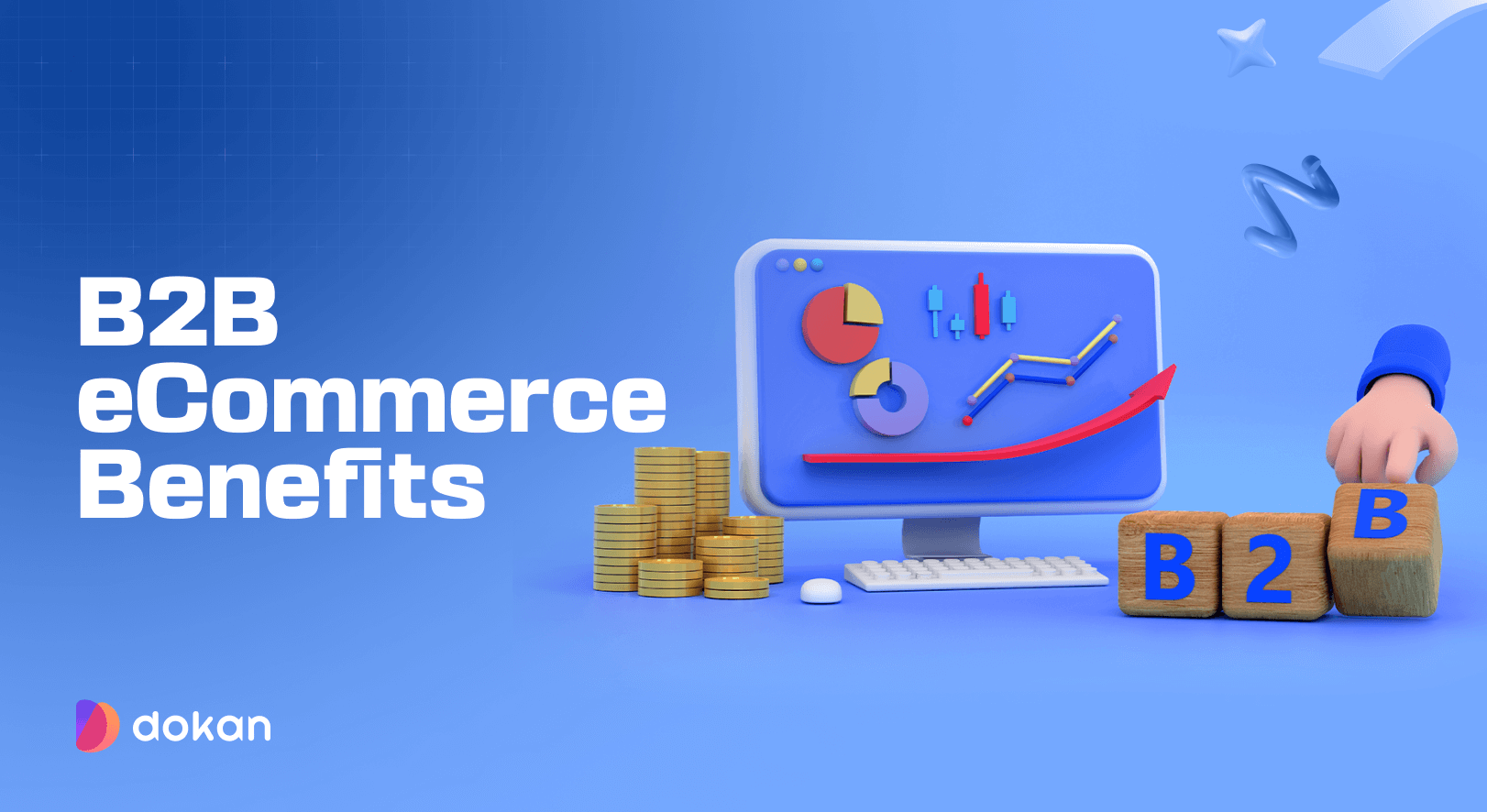B2B eCommerce, or businesses selling to other businesses online, is a big deal. It’s not just a trend anymore—it’s essential for keeping up with the competition and meeting the needs of modern buyers.
Whether you’re a big company or just starting out, understanding the benefits of B2B eCommerce is super important for growing your business and making customers happy.
In this guide, we’ll talk about all the good things that B2B eCommerce brings.
So, let’s dive in and learn why B2B eCommerce is so cool and why you shouldn’t miss out on these benefits in the coming year. Whether you’re thinking about selling online or want to make your current online business better, this guide will help you understand how B2B eCommerce can help you succeed.
Why You Should Create a B2B eCommerce Business in 2024
People are prioritizing comfort and convenience over anything else in this world of internet-enabled services and making online purchases for both B2C and B2B.
B2C was already successful in the eCommerce arena while the B2B eCommerce market has seen unprecedented growth in the last few years.
Both B2B and retail businesses are going digital. 61% of the total B2B market has already shifted to online platforms. The percentage is increasing each year.
But why create a B2B eCommerce business now, you ask?
Here’s why you should join the ride:
- Untapped Potential: The B2B eCommerce market is a sleeping giant, with a massive chunk of transactions still happening offline. Be an early adopter and grab a significant share of this rapidly growing market.
- Efficiency on Steroids: Imagine streamlined ordering, 24/7 access for your customers, and automated processes that free up your team’s time. B2B eCommerce cuts costs, boosts productivity, and lets you focus on what matters – building relationships.
- Happy Customers, Happy Business: B2B buyers crave the same convenience they experience as consumers. Offer them a user-friendly online store, real-time order tracking, and self-service options. Happy customers lead to stronger partnerships and repeat business.
- Global Reach, Local Impact: Break down geographical barriers! With an online platform, you can showcase your products to a worldwide audience, attracting new customers and expanding your reach exponentially.
- Data-Driven Decisions: B2B eCommerce unlocks a treasure trove of customer data. Gain valuable insights into buying habits, preferences, and trends. Use this data to personalize your offerings, predict demand, and make smarter business decisions.
- The Future is Now: B2B eCommerce isn’t a fad, it’s the future. By creating a B2B eCommerce business, you position yourself as a tech-savvy leader, attracting talent and investors who understand the power of digital transformation.
By creating a B2B eCommerce business in 2024, you’re not just building a business, you’re building a future-proof powerhouse.
Top 11 B2B eCommerce Business Benefits in 2024

B2B transactions have reached a new height after adopting the eCommerce model. Almost 20% of B2B transactions are likely to be generated through digital platforms.
More and more business leaders are investing in digital B2B eCommerce to enjoy its benefits. Keep reading to learn the key B2B eCommerce benefits:
- Improved Scalability and Growth
- Better Reach to Customers
- Enhanced Customer Experience
- Agile Development Process
- Increased Productivity
- Omnichannel Experience
- Flexible Payment Options
- Accurate Data And Insights
- Streamlined Sales Process
- Efficient Inventory Management
- Reduced Human Error
Now let’s get into the details!
1. Improved Scalability And Growth
The B2B eCommerce market size is five times bigger than that of B2C. So, B2B eCommerce offers more scope of business if you can rightly capture the target market. The digital platform allows business owners to grow and scale their businesses easily with the help of both open-source and SaaS platforms.
A top-quality eCommerce website is mobile-friendly, fast, and easily discoverable being aligned with the best SEO practices. It allows business owners to onboard multiple vendors and expand their business with a minimal workforce.
The easy onboarding and product assortment process make it very straightforward to upscale a B2B eCommerce platform.
2. Better Reach To Customers
More people are turning to online shops to buy for their businesses. B2B eCommerce is experiencing an increase in every aspect. That means you have a significant customer base.
“And 81% of online shoppers perform online research before making a buying decision.”
So, you can easily reach a great number of prospective customers by addressing people who search for the best products at competitive prices on the Internet.
Your customers are comparing several products, looking for the best prices, and browsing the internet for authentic products. You can reach them by leveraging the power of SEO, content marketing, and digital marketing.
A highly responsive website with excellent UI and UX designs and top-quality content and product catalog has great chances to rank higher on search engines. This will increase your brand awareness, engage potential leads, and boost your sales eventually.
3. Enhanced Customer Experience

In the previous section, we saw that almost 40% of buyers now like to follow the do-it-yourself method instead of speaking to company representatives. You can cater to these customers easily by designing an eCommerce website that has a user-friendly self-service portal.
Relevant product information, reviews, shipping details, comparison charts, and secure payment methods are a few of the basic considerations required to provide a better customer experience.
B2B eCommerce websites can easily implement these functionalities into the buying process. Even advanced features such as order history, delivery tracking information, personalized product suggestions, etc. are also becoming regular features nowadays.
Thus, you can offer an excellent user experience for customers with B2B eCommerce websites.
4. Agile Development Process
B2B businesses must have the ability to adopt new technologies, patterns, and changes quickly. You may need to open an online store quickly, shift to a new market, or upscale your business to keep pace with the market growth.
The agility of B2B e-commerce allows you to build a web store in multi-languages, integrate various payment methods and currencies, and grow your business beyond boundaries.
5. Increased Productivity
B2B organizations can make use of enterprise resource planning (ERP) to increase efficiency and productivity to a great extent. An ERP system eliminates the hassle of heavy paperwork and saves time and resources.
You can operate your business effectively with fewer people by integrating automation. The ERP system can automatically process information like order numbers, total revenue, profit percentages, discounts, and more.
Since your customers are making orders themselves on the B2B eCommerce website, you can invest your time to improve customer satisfaction and retention rates. Thus, you can do more tasks in less time and focus on customer service instead of just taking orders.
6. Omnichannel Experience
All your customers are not searching for your products or services on the same channel. Some may find you on LinkedIn, some may find you on Facebook, and others may enter your website from the search results.
“Today, 94 percent of B2B decision makers say the new omnichannel sales model is as effective or more compared to the sales model they used before the pandemic.”
McKinsey & Company
An omnichannel approach ensures that your customers have a seamless experience no matter where they come from. B2B businesses provide scopes to offer an omnichannel experience for their customers.
7. Flexible Payment Options
B2B eCommerce can integrate multiple payment methods including credit/debit cards, PayPal, mobile financial services, and more. These flexible payment options also support the major currencies available in the world.
A payment process equipped with an invoicing module, accounting software, and a physical cheque support system caters to the needs of every online shopper. Such a flexible and streamlined checkout process is one of the main B2B eCommerce benefits.
8. Accurate Data And Insights

With the growing competition in the eCommerce arena, you can’t afford to make silly mistakes. One simple mistake can place you far behind the competitors. B2B eCommerce can be integrated with ERP, CRM, procurement, and other relevant software to help users get accurate data.
You can easily make data-based decisions about pending orders, fulfillment needs, stock counts, and other crucial factors related to inventory management.
Besides, there are several analytics tools that can help you get deeper insights into the conversion rate and buyers’ behavior, and you can also track the performance of your marketing campaigns using these tools.
9. Streamlined Sales Process
More and more people are looking for a seamless buying process across B2B eCommerce websites. Online sales platforms have become an alternative to salespeople.
“Nearly 75% of B2B buyers now say that buying from a website is more convenient than buying from a sales representative. Further, 93% say that they prefer buying online rather than from a salesperson when they’ve decided what to buy.”
Forrester
You need to have a B2B eCommerce back-office that can provide customers with valuable information like order history, personalized rate, stock availability, shipping cost, estimated delivery time, and more. If a buyer gets all the information he needs, he will happily complete the transactions without leaving the cart.
10. Efficient Inventory Management
In B2B transactions, usually, the order volume is bigger than that of B2C. You must have an automated inventory management system that synchronizes stock availability information across all channels. It harms the reputation of a brand if it takes orders but fails to deliver due to stock outages.
A B2B eCommerce site can solve this problem by integrating a system that processes customers’ orders in real-time, tracks the orders, and updates the inventory status accurately. It can also help users anticipate the future demand for a particular product and replenish it accordingly.
11. Reduced Human Error
What’s the traditional way of receiving orders in B2B business? A customer makes an order via phone or email. Then a company representative inputs the order details manually and sends the information to the assigned department. Then they ship the order as per the information. You may need to maintain multiple spreadsheets to process one order.
Data like order details, stock information, shipping costs and updates, and more are managed manually by the in-house team. There are several scopes of human errors when people from different teams manage and track the information without centralizing the database.
A B2B eCommerce platform centralizes all data in one place, reducing human errors to almost zero. Anyone with permission can access all order-related information in real-time from a single source.
You no longer need to transfer data manually and perform the mundane tasks of managing multiple spreadsheets. With an effective eCommerce platform in use, you can reap these excellent B2B eCommerce benefits.
Best Practices to Reap The Benefits of B2B eCommerce

You won’t be able to enjoy B2B eCommerce benefits without streamlining your eCommerce platform in every aspect. From customer service to product assortments and shipment, you need to go the extra mile to create a successful B2B eCommerce platform.
Follow the below basic steps to avail the advantages of B2B eCommerce:
I) Promote Your eCommerce Platform to Customers
Your customers will never know how good you are until you reach them. Promoting your B2B eCommerce website is the first step in launching an online store. You can send emails, use social media platforms, publish press releases, run paid advertisements, write blogs, advertise in local newspapers, and more to promote your marketplace.
II) Create User-friendly and Simple Navigation
Make sure that your customers find it very straightforward to search and navigate across all sections of your website. Every customer expects a smooth user experience and wants to buy their desired products within as few clicks as possible.
Focus on remembering order history since B2B customers usually reorder the same products. It will help you retain repeat customers.
III) Streamline Catalog for Easy Search
Use common names, keywords, or terms to describe products. Keep the product description understandable to the target audience. Acronyms, part numbers, and technical jargon often confuse regular customers.
So include technical terms only when necessary. Use sharp and clear pictures relevant to the products. Focus on SEO to make the products search-friendly across the website and search engines as well.
IV) Adopt a Customer-centric Approach
All your content and website navigation should be designed to please the customers. The user experience must remain uninterrupted and the user interfaces must look aesthetically pleasing. Keep the sales funnel easygoing for the customers so that they can easily complete transactions without getting distracted.
V) Make Data-based Decisions
Don’t make any decisions based on assumptions. Keep a close look at the sales trend and demand of a product especially when you’re re-stocking it. If you can’t sell products, they will become a burden and occupy a significant place in your inventory.
Use analytics to get actionable insights into the customer engagement metrics, stock availability, conversion rates, cart abandonment, and more. Once you know the right number, you can act on them.
Bonus: 7 Common B2B eCommerce Mistakes to Avoid

The first mistake B2B eCommerce owners make is choosing the wrong platform to host their business operations. They often select a budget-friendly eCommerce solution that gives the initial boost but gives birth to serious problems in the long run.
Let’s have a look at the most common mistakes to avoid when getting started with B2B eCommerce.
- Choosing Wrong Deployment Models: Don’t fall into the trap of inexpensive eCommerce platforms. Choose an eCommerce platform that can assist you in achieving your business goals. An easy-going, cost-effective deployment model might not be a good choice if you want a sustainable business.
- Thinking B2B Buyers Prefer to Buy Offline: A good number of e-commerce owners think B2B transactions mainly occur offline. On the contrary, studies show that 93% of people prefer to buy online without having to talk to a salesperson.
- Failing to Integrate Effective Systems: ERP, CRM, Payment Management Tool, Inventory Management Tool, etc. are a few systems that can improve the efficiency of an e-commerce system. Many companies fail to integrate such tools and software into their e-commerce platform and can’t offer a seamless user experience for their customers.
- Ignoring the Importance of the Mobile-first Approach: 80% of B2B buyers use their mobile devices at work and 60% of them admit that mobile plays an important role when they make a purchase. So, you’ll lose more than 50% of customers if you can’t build a mobile responsive B2B e-commerce website.
- Paying Less Attention to Personalization: You can’t impress your customers without connecting with them at personal levels. Gather data about your customer’s buying journey, and shopping behavior to create buyer personas. And address them through a personalized voice.
- Giving Less Priority to Security and Privacy: Since eCommerce websites deal with confidential information about customers’ credit card credentials and addresses, buyers won’t buy from you if they don’t feel secure. Privacy and security should be at the top of your priority list. Integrate a secure payment gateway and use SSL certificates to enhance the security of your website.
- Thinking Marketplaces are Costlier: It’s true at some points that building a marketplace may become a costly investment. You need to identify your business goals and choose an open-source or SaaS marketplace platform tailored to your needs. Carefully consider the hidden expenses related to maintenance and updates. Sometimes, maintenance costs exceed the initial development costs.
Choose the Best eCommerce Model for You
Over the past few years, the eCommerce industry has boomed worldwide. It’s one of the most profitable and viable businesses today to launch an eCommerce site, regardless of whether it is B2B or B2C.
Now that you know the benefits of B2B eCommerce, you can make an informed decision about whether you should choose B2B eCommerce over B2C eCommerce. The success of B2B marketing requires a lot of time, money, and effort. Here, the order volume is higher but it’s difficult to onboard buyers. Once you can manage all these things, it will help you make a big amount of money.
In contrast, you can start a B2C eCommerce business for a small investment. Here, the number of buyers is higher but the order volume is lower. So, you are likely to make a smaller profit margin with the B2C model.
B2B is more complex since it deals with companies where business needs play a significant role, whereas marketing solely plays a pivotal role in B2C business. Both business models have pros and cons. You can choose either B2B or B2C eCommerce as you see fit for your business.
Subscribe to
Dokan blog
We send weekly newsletters, no spam for sure!

